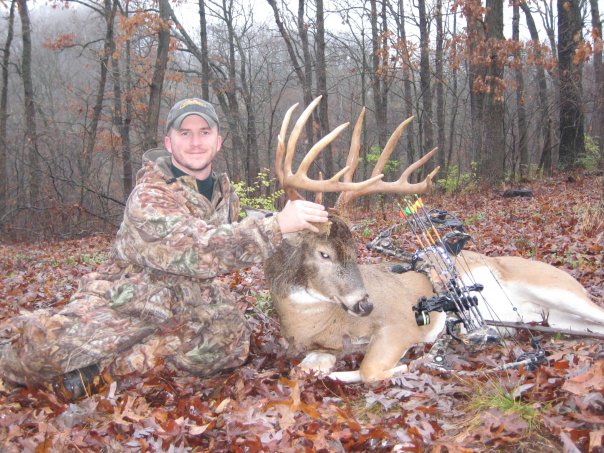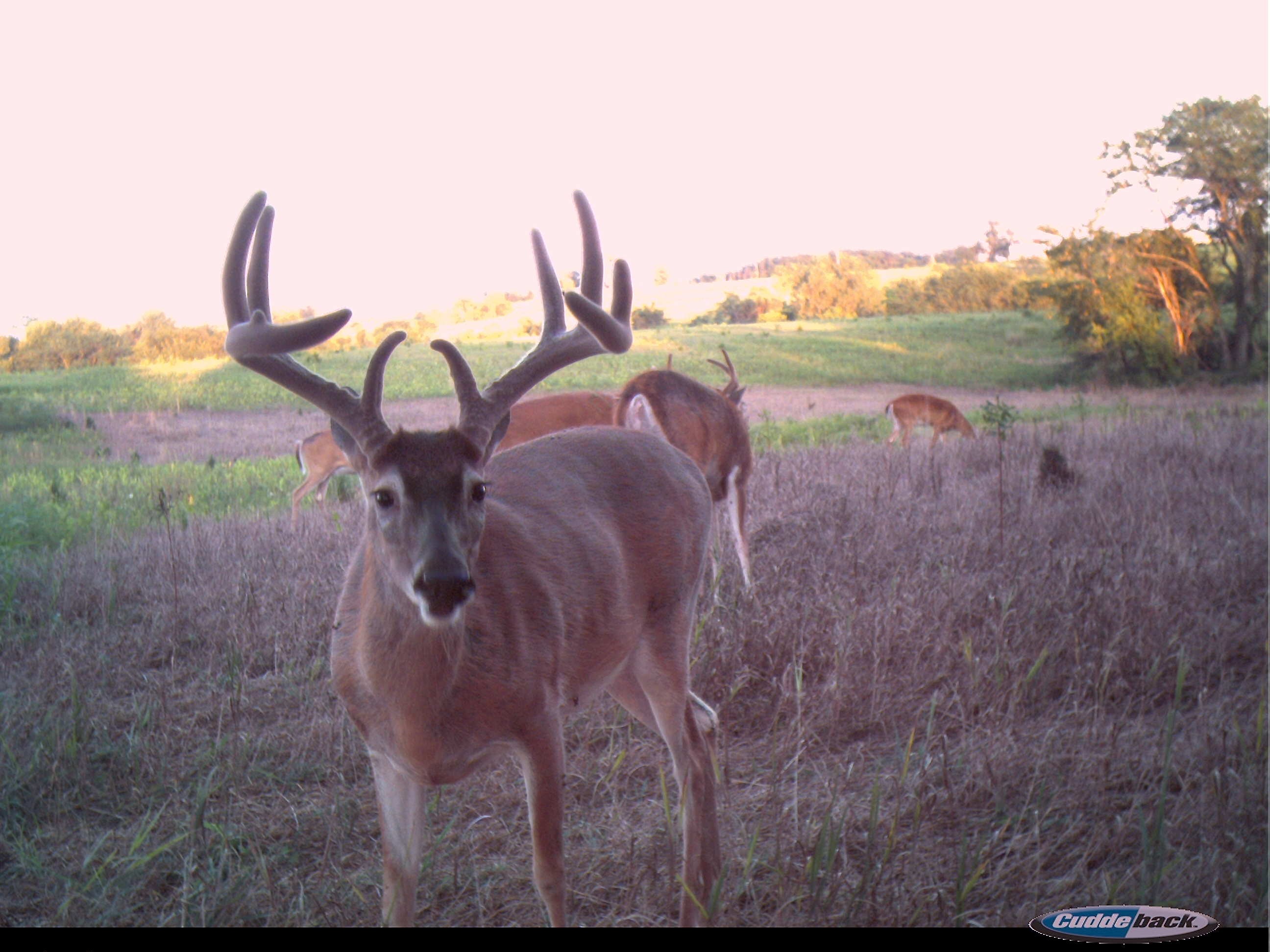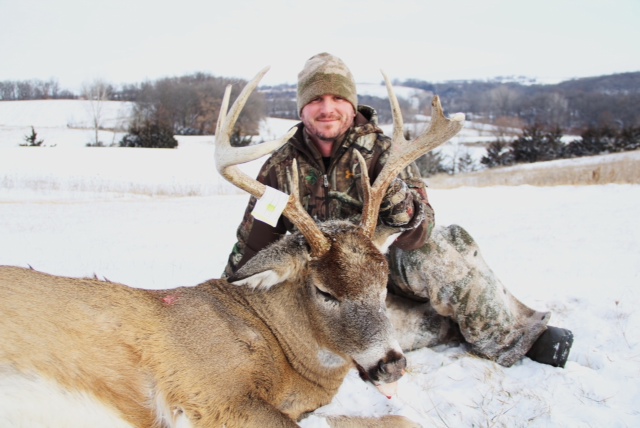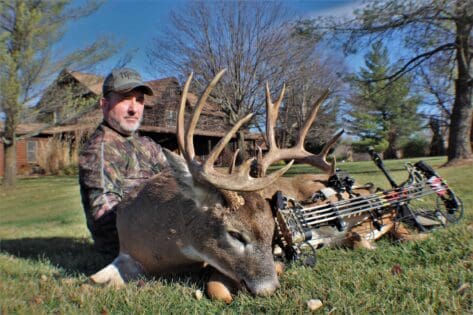Deer Herd Health in the Midwest
 I guess one could say that I stay in tune with the whitetail deer hunting world all year long. I visit hunting forums, social media, websites, read magazines, and subscribe to various blogs and e-articles. I don’t have outdoor television programming at my house so I really don’t pay much attention to that aspect of deer hunting, and frankly it doesn’t appeal to me much anyway. The success and failure of “average joe” hunters and sage advice from actual experts is where I choose to focus my attention. When visiting these various outlets of information I often see trending topics from these two groups.
I guess one could say that I stay in tune with the whitetail deer hunting world all year long. I visit hunting forums, social media, websites, read magazines, and subscribe to various blogs and e-articles. I don’t have outdoor television programming at my house so I really don’t pay much attention to that aspect of deer hunting, and frankly it doesn’t appeal to me much anyway. The success and failure of “average joe” hunters and sage advice from actual experts is where I choose to focus my attention. When visiting these various outlets of information I often see trending topics from these two groups.
One topic that seems to have really been brought to the forefront this past year is the health of the deer herd in the Midwest. Reduced harvest totals, lack of deer sightings, lack of trophy buck sightings, all seem to be fairly common discussion topics across many states in the trophy buck regions of the central US. Many experts, pseudo experts, TV personalities, and armchair deer managers have all taken to the pen and keyboards to express their opinions of the deer herds’ current condition. I think it is safe to say that most are saying that the deer hunting was pretty poor during the 2013 season. There are varying opinions as to why this occurred and I will undoubtedly present my own before I am done. For now I will turn my attention to the reasons that some are presenting.
When I say that the deer hunting was slow this year I am not talking about an isolated area. Reports from Illinois, Iowa, Wisconsin, Michigan, Kansas, Missouri, Minnesota, and several others are all presenting similar data. Lower harvest totals and reduction in deer sightings. Many hunters have grabbed this information and turned it into some Doomsday Prophecy about the future of deer hunting. The old fashioned hunters, who don’t believe in doe harvest, are now saying ”I told you so”. The conspiracy theorists are blaming the DNR. The QDM people are blaming ignorant hunters. Many more are blaming EHD. The list goes on and on. Everyone has their finger out pointing at what they feel caused the poor hunting season this year. Many think that one of these things or a combination of these things has been the destruction of our deer herd and it will take years to recover.
Many states have drastically liberalized antlerless deer tags in the last decade. This has been a controversial topic since inception and will always continue to trigger some heated debate. Hunters who have seen their deer sightings drop, fault the DNR for being greedy or bowing down to insurance companies to allow too many antlerless deer to be harvested. I will not argue the status of any one county or states deer numbers. I am not everywhere and cannot specifically account for the rise and fall of a given population based on doe harvest. One thing I do know is that there is never a happy deer number for the human population. There will always be opinions from hunters, farmers, biologists, and special interest groups. Do I agree with all DNR policies and actions? Absolutely not! But I also know that my opinion is my own and there will be people who differ from me. How is one entity supposed to make decisions that satisfy every individual desire? Please don’t kid yourself that there is a compromise out there either. Compromise equates to losing for both parties so they are still unhappy. Until the hunters themselves take responsibility for the current status of the deer herd, success will never be achieved. The DNR will never fix “your” problem as a deer hunter they can only provide the tools for success or downfall.
EHD, HD, Blue-tongue (choose your disease) has been a recurring issue over the last several years in hard hit drought stricken areas. This has had a noticeable negative impact on some hunters’ success the last few years. Most of us have heard horror stories of hunters finding dozens of dead deer on their farm in the late summer months only to find several more dead in the winter. Does HD have a legitimate impact on areas that it affects? Without question. However, many people do not understand how this disease works. It is not the same as CWD or TB that have had dramatic impacts on certain hunting areas as well. It is not a disease that stays and spreads. It may affect your farm and not your neighbor. It can affect large population densities but generally is more isolated. The problem with all of the discussion revolving around this topic; is that hunters who have heard stories of dead deer often automatically associate their poor hunting with some massive deer “die off”. The fact is their problem may be totally un-related to HD. That fact does little to relieve the perception. The silver lining for those of you who have experienced great losses from this disease is that deer are very resilient. Biologists have determined that survivors of EHD can build an immunity, and they can pass this immunity to their offspring. If this is true then the deer herd of the future should be stronger from the experience of the last few summers. Deer populations also have the ability to rebound rapidly when conditions are favorable. Areas with low deer densities now, can have plentiful populations in as little as a few seasons.
 The final debate that I have heard and participated in is the lack of quality trophy animal sightings this year. I personally know of many people who have run trail cameras all summer and fall, and hunted the majority of the season and have very few trophy buck sightings to show for it. They are not finding dead bucks, they are not getting pictures of big bucks in velvet only to have them disappear, they are not seeing them in the distance during bow hunts, they are just not seeing them. I have heard opinions on this vary from, too many 3 ½ trophy caliber (use that term loosely) being killed, too many bucks in general being killed, too many hunters, too many does being shot so the crop of young bucks is minimal, etc. Obviously any of the above mentioned items can be detrimental to the trophy potential of a given area. Have some areas seen too much hunting pressure resulting in unbalanced age structure? Sure! Are some hunters’ view of what constitutes a trophy different than others? Absolutely! Is the recruitment rate for trophy bucks lower in areas that have been hit hard by EHD and excessive antlerless harvest? Probably so! But there is no way this can account for a widespread phenomenon, including land that is under strict trophy management.
The final debate that I have heard and participated in is the lack of quality trophy animal sightings this year. I personally know of many people who have run trail cameras all summer and fall, and hunted the majority of the season and have very few trophy buck sightings to show for it. They are not finding dead bucks, they are not getting pictures of big bucks in velvet only to have them disappear, they are not seeing them in the distance during bow hunts, they are just not seeing them. I have heard opinions on this vary from, too many 3 ½ trophy caliber (use that term loosely) being killed, too many bucks in general being killed, too many hunters, too many does being shot so the crop of young bucks is minimal, etc. Obviously any of the above mentioned items can be detrimental to the trophy potential of a given area. Have some areas seen too much hunting pressure resulting in unbalanced age structure? Sure! Are some hunters’ view of what constitutes a trophy different than others? Absolutely! Is the recruitment rate for trophy bucks lower in areas that have been hit hard by EHD and excessive antlerless harvest? Probably so! But there is no way this can account for a widespread phenomenon, including land that is under strict trophy management.
So, I have explained the frustrations of hunters as briefly as I could. The problem that I have with the attempted explanations of why the deer hunting was poor in 2013 has to do with the scale of the event. There is NO way that any of the above mentioned topics can account for the widespread disappointment in the deer hunting this year. EHD did not kill all the deer in an 8-plus state area, the DNR in every state didn’t allow too many deer to be killed on every farm, hunters did not kill all of the 3 and 4 year old bucks last year….so what happened??
My feeling is that people are painting this whole topic with very broad strokes. I think that different states, different counties and even different farms were impacted by a series of issues that created the perfect storm for poor deer hunting on a very large scale. In addition to some of the topics mentioned above I have some ideas that I want thrown in the mix. Much of the Midwest had a very wet spring. Rotational crops were getting planted up to July 4th in my neck of the woods. The result was massive amounts of standing crops all the way up to early December. Anyone who has hunted here knows that is a problem. 2013 was also an extremely productive acorn growing year. Around Christmas I took a walk around a timber burn on my family property in Illinois. The intentionally burned forest floor was literally covered with acorns. So many acorns that it was difficult to walk. It is a fact that white oak acorns are the number #1 food source for the whitetail deer when they are available. Mature whitetail bucks can become even more reclusive during big acorn crop years because they do not need to travel to find food. If the deer rarely need to travel to food or come out into the open to find food, sightings will be dramatically reduced. I believe these two issues account for much of the deer disappearance across the region.
 The issue of reduced trophy deer numbers is a very real one, but I believe the widespread cause has yet to be discussed. From the summer of 2011 through the spring of 2013 there was an extensive drought across the central US. Crops suffered, native vegetation suffered, and the animals suffered. This stress reduced the nutritional content of the native browse (which constitutes a large portion of the whitetails’ diet) and reduced the quality of agricultural and food plot crops. It also stressed the deer from a reduced water source perspective. It is a biological fact that a whitetail buck under stress will grow a smaller rack. A stressed buck that is receiving lower quality nutrition will go into the fall/rut/winter periods lighter in body weight and generally poorer physical condition. The rigors of the rut and winter will leave the buck in a weakened state headed into the antler growing season. That weakened buck’s body will not put as much emphasis on antler growth as it does into restoring the overall physical condition of the animal until the buck is once again healthy. This will create a setback for antler growth. So if all the mature bucks have been deprived nutritionally for the better part of two years it stands to reason that their racks, despite their genetic potential, would be smaller than if they were not stressed and 100% sound physically. One could argue that there are still giant bucks being killed and that is absolutely true. Tell me this though…if a 220 inch whitetail buck dropped 15 inches in one season would anybody notice or care?? What if a mature buck dropped those same 15 inches from 160 to 145 inches. That buck just went from an attention getter to an average buck. What if that same exact thing happened to a large percentage of the mature bucks in the region? One could speculate that there would be a massive reduction in sightings of monster bucks. Having the opportunity to observe bucks for many years of their life on a large tract of land, I can tell you that I did not see a shortage of mature bucks this year in the ages of 4 ½ and older. What I did see was a lot of bucks in that age group that grew very average antlers between 130 inches and 150 inches. I shot an 8pt. this archery season that was 5 ½ years old and was probably only 5-8 inches bigger than he was as a 3 ½ year old. Now maybe that was his genetic inclination but given the number of bucks that performed just like he did, I tend to believe he contributes to my theory.
The issue of reduced trophy deer numbers is a very real one, but I believe the widespread cause has yet to be discussed. From the summer of 2011 through the spring of 2013 there was an extensive drought across the central US. Crops suffered, native vegetation suffered, and the animals suffered. This stress reduced the nutritional content of the native browse (which constitutes a large portion of the whitetails’ diet) and reduced the quality of agricultural and food plot crops. It also stressed the deer from a reduced water source perspective. It is a biological fact that a whitetail buck under stress will grow a smaller rack. A stressed buck that is receiving lower quality nutrition will go into the fall/rut/winter periods lighter in body weight and generally poorer physical condition. The rigors of the rut and winter will leave the buck in a weakened state headed into the antler growing season. That weakened buck’s body will not put as much emphasis on antler growth as it does into restoring the overall physical condition of the animal until the buck is once again healthy. This will create a setback for antler growth. So if all the mature bucks have been deprived nutritionally for the better part of two years it stands to reason that their racks, despite their genetic potential, would be smaller than if they were not stressed and 100% sound physically. One could argue that there are still giant bucks being killed and that is absolutely true. Tell me this though…if a 220 inch whitetail buck dropped 15 inches in one season would anybody notice or care?? What if a mature buck dropped those same 15 inches from 160 to 145 inches. That buck just went from an attention getter to an average buck. What if that same exact thing happened to a large percentage of the mature bucks in the region? One could speculate that there would be a massive reduction in sightings of monster bucks. Having the opportunity to observe bucks for many years of their life on a large tract of land, I can tell you that I did not see a shortage of mature bucks this year in the ages of 4 ½ and older. What I did see was a lot of bucks in that age group that grew very average antlers between 130 inches and 150 inches. I shot an 8pt. this archery season that was 5 ½ years old and was probably only 5-8 inches bigger than he was as a 3 ½ year old. Now maybe that was his genetic inclination but given the number of bucks that performed just like he did, I tend to believe he contributes to my theory.
The last part of the problem that I will discuss is the expectations of the hunters today. The deer hunting in the late 90’s and early 2000’s was very good. There were healthy populations, ample trophy bucks, and moderate hunting pressure across most of the Midwest. Then as the emphasis on trophy buck harvest increased, the overall population control effort was reduced and there was a dramatic surge in deer population. The deer numbers were at unhealthy high capacity. Farmers were angry, car insurance companies were angry, and many deer hunters were happy. People would brag about the numbers of deer they were seeing and success rates were high. People concerned about trophy quality were not as excited about the deer explosion. Those people knew that areas of the country with the highest deer populations generally have some of the poorest quality animals. I call it the “fish tank theory”. If you take a 25 gallon fish tank and put 30 goldfish in there they will all remain relatively the same small size for their lifespan. If you use the same tank and put 1 goldfish in there, he will grow dramatically bigger. Less stress, less competition, more food = bigger goldfish. Simple theory indeed and it directly relates to the whitetail world as well. To grow the largest bucks possible for your area you cannot max out the carrying capacity of the land. It just doesn’t work. As the deer numbers reached an all time high in 2005, hunters in several states were given the opportunity to reduce these numbers with the addition of late antlerless seasons and numerous antlerless tags. Over the next several years these seasons did their job and started reducing the populations across the region. All the while hunters were complaining that the harvest totals were dropping every year. Yes, of course they were, because there were less deer. Now the population numbers in most areas are more reflective of the late 90’s and early 2000’s and many hunters are upset. They are upset because they are referring to the “glory days” of deer hunting as the mid-2000’s when populations were out of control. Those were not the glory days of deer hunting. With better education, better management strategies by landowners, and a manageable deer herd size. I feel that the glory days for deer hunting are lying ahead of us.
Every deer season is not going to be better than the last. We will encounter bad years throughout a cycle of a lot of good years. We have had a whole lot of good seasons for the last decade as deer hunters and we were bound to have a bad one. The population will go in peaks and valleys as hunters and DNRs’ try to juggle what they feel is the best course of action. EHD will come and go. Popular hunting trends and management strategies will come and go. DNR directors will come and go. But, the deer will live on and I fully intend to be out there chasing them as long as they will have me. One bad season should not be enough to vilify anyone or change our management objectives. We should take an educated approach moving forward with a balanced management strategy for maximum enjoyment in the field. This will not happen in spite of the DNR but only with them as co-sponsors. Hunters must educate themselves and voice their opinions to the people that matter.
I feel that we are going to experience a great 2014 deer season in many areas of the Midwest as long as Mother Nature gives us a break. Don’t let the 2013 discourage your dreams or twist your views. Cheers to a New Year and the big bucks that will haunt us this fall.
Corey J. Wilkinson
Last Updated: January 15th, 2014





I can’t see how giving out unlimited doe tags can’t be the problem. I have 350 acres of timber at one farm and the neighbors will hunt until the last second of daylight so they can fill 3,4,5 and sometimes 6 doe tags. How can the deer recover from this? Makes no sense. We have shot 2 does in the last 4 years and only seen 12 deer the entire 7 days of gun season.we manage with food plots and 200 acres of set aside timber. Just doesn’t make sense . I feel greed by conservation dept for money. We are in st. Clair county.
Excellent article Corey! Very well done!!
Very well spoken Corey. I shared it via FB; hope you don’t mind 🙂
Corey, I would like to discuss your article more but not here. If you would like to talk more you can reach out at dave@davefredrickson.com
Thanks
I think you have it wrong. Liberal doe harvest, if continued will compound the problem. Politics and private interests are reducing deer numbers all across the midwest and Northeast. You can sit and wait for it to get better, or maybe join those representing the voice of the hunter for change.
With all due respect, I disagree with your article. I hear it very frequently that there is nothing wrong with the deer herd but most of the time these come from people with large tracts of private land or co-ops hunting a well managed herd that is WELL above the defined carrying capacities set by local deer managers. Hard to have a real view on the problem in a situation like that. I hunt on a variety of private and public grounds in northern WI that have been decimated by a liberal doe harvest. While you say the glory days may be over, pre 2005, that was when the heard was balanced and healthy. There were no evident browse lines and could see 20-30 unique deer in a given season where as now I see maybe 5-10. It’s very to feel like nothing is wrong until you are the one effected. Now is the time for hunters to be united for a change instead of squabbling amongst eachother. Brooks hit this square on the head.
I think that those of you in disagreement with me may have missed some points in my article. I believe I stated that some areas may have been adversely affected by excessive doe harvest, EHD, and improper management. The take away from the article was that not everyone’s deer hunting problems are from the same cause of too small of a deer herd. The deer herd in the entire Midwest is not all in dire straits. You all are trying to manage every piece of land in an 8 or 9 state area off a simple management strategy of reducing doe harvest. The deer herd may very well be in poor shape on your 300 acre farm or your whole county and I am not disputing that. I hate that your herd is in this condition. However, there are a lot of people who assume that their hunting is poor because of the same reasons because they read stories of dead deer or DNR greed on the internet. I am merely offering an alternative perspective and trying to stimulate an educated response to the issue instead of one d
Very good article Corey. One thing I am personally sick of hearing from hunters is the blame game. For the past 10 year’s all I heard from QDM know it alls and the self proclaimed better than average hunter is shoot does keep your doe to buck ratio in check. Along comes EHD wipes a lot of big bucks and tons of does out of the herd. And what do we get? Them same people blaming everyone but themselves for the problem. Best solution if you have a major shortage of deer around you stop hunting for a year or 2 and spend more time on your property if available making it a deer paradise with plenty of available food and cover. We all have seen or heard of that property the little old lady has and no one hunts and that’s where all the deer go gun season. Hopefully your right Corey about 2014 because another couple years of listening to complaining deer hunters could get real old.
I would say MN biggest problem is that in many areas EVERYONE gets a buck tag, and does are by lottery only. Now if you have 8 days to hunt the shotgun season with a buck tag, that little juvenile 4 pointer is the only buck you might see, and you want meat in the freezer. So you shoot it, putting meat in the freezer but removing genetic variability from the local deer population.
I hunted nearly every weekend during bow season and for 5 days of the shotgun season. The only buck I saw was that little 4 pointer, who I let go. Saw many groups of does though.
Meanwhile in the close by state Missouri, the state has a very liberal doe policy and is becoming known for growing huge bucks.
You are definitely wrong and going thru every aspect doesn’t make your point right.. As I explained to our odnr they give out 8 deer tags.. Why. The people that eat deer where I live eat deer throughout the year.. They kill 8 and freeze them.. 3 months later it’s freezer burnt.. They feed them to their dogs.. Then go and kill a fresh one.. How about nuisance permits.. Farmers I know put gut shots on them ..don’t go look for them and keep on going.. Hell the people kill them just to feed their coon dogs.. What I’m trying to say is there is way to many getting killed that are not taking into account for..if this wasn’t true why all the complaints.. Coyotes.. The odnr guy said its because we are lazy.. I bow hunt only.. I guess it is being lazy sitting in a tree stand all day..F.U.. Lazy is going out spotlighting and counting how many deer he sees gathered together in the winter and then making an assessment on how big the deer herd is in that co.. I digress it is worthless.. maybe you wi
Corey,
Very interesting article and fascinating to see that hunters opionion like those presented reside everywhere. Here in Michigan we have seen a drop in deer #’s due to TB and only in those regions inwhich the DNR designated as a high risk. A doe a day tag allowed for many years and still goes on and has dropped the population drastically in those regions, with little evidence of confirmed TB deer each year.
I hunt on 12,000 acres(private land) and still we see up and down deer numbers. The acron theory you described is spot on. We use to laugh at the fact that deer did not have to look for food some years, just rool over eat and go back to sleep. We manage our herd, for a health balance across the heard. It is a journey, as not all hunters see the need to balance the doe to buck ratio. We also do our share the manage the forest. We harvest our old growth to improve browsing. Even with all the decades we have done these, we still see the effects that you described in 2013.
Corey, I agree with what you have written in your article. All the factors mentioned play a part in deer herds as a whole. I am a guide in South Texas and we see some of the same issues you mentioned. #1 being “Trophy” bucks. Everyone knows Texas is known for it’s millions of deer and exceptionally large antlers. However, that being said, we probably more than anyone, see the effects of drought on a herd. I personally have followed a particular buck for 3 years and each year his antler size fluctuates up and down depending on our rain situation. At 2 1/2 he was a main frame 10 scoring roughly 125-130 which was a semi-dry year. The next year was extremely dry and he seemed to be about the same size but less mass. Last year we got our rains at just the right times although we were still in a drought but he put on roughly 20 inches. This year is still dry, but again, rains have fallen at just the right times keeping things green. Still waiting to catch him on camera but based on what I’m
Rick, Glad to hear some feedback from Texas. I know that the SW is very susceptible to the drought and it’s impact on the animals. I have heard many regional biologists in that area state that rainfall is the #1 determining factor in animal quality. We cannot overlook that factor in the Midwest either and I believe that many have. Hopefully we are only a rainy year away from a return to a quality herd.